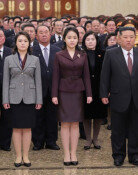Documentary vividly depicting Paik Nam-june’s life is screened
Documentary vividly depicting Paik Nam-june’s life is screened
Posted April. 10, 2023 07:51,
Updated April. 10, 2023 07:51

A small Asian man with short and tousled curly hair walks around in a gallery and works on machines. It was Paik Nam-june who held the first video art exhibition at Galerie Parnass in Wuppertal, Germany in 1963. German media harshly criticized his exhibition by saying that a young South Korean artist wanted to shock the audience but the results were lackluster. However, he later became a globally-renowned artist.
The documentary titled “Nam June Paik: Moon Is the Oldest TV,” directed by Korean-American director Amanda Kim, premiered in the U.S. this year. The first-ever documentary focused on Paik shows how he survived as an artist. Ulsan Art Museum, which owns the movie title, held a preview in Arthouse Momo of Ewha Campus Complex in Seodaemun-gu, Seoul on April 29. The film was screened at Ulsan Art Museum from Thursday through Saturday.
The documentary focused on the artist’s life rather than his deeper artistic context. It consists of videos featuring Paik, his writings, and interviews with artists who remember him. Steven Yeun from “Minari” narrated Paik’s writings. The interviews in the movie were conducted with cellist Charlotte Moorman and Merce Cunningham, who collaborated with Paik, as well as with his wife Shigeko Kubota, and his great nephew Ken Hakuta.
What’s interesting is the videos of Paik while he was alive. The snapshots of his life where he was nervous before his first exhibition, was bitter but did not care much about the media’s harsh criticism, and continued to pursue his artistic belief amid anxiety were included.
Paik said he became a completely different person and gained the courage to become free after watching experimental musician John Cage’s performance in 1957. He applied such freedom to television and broke the rule of television that images are broadcasted in one direction. He used magnets on Braun tubes to distort images and renovated televisions so that audience could control images.
The movie also features a story that his wife saved his work and records on a pouring day while the two lived in a house with a leaking roof due to poverty. Paik said he might have committed suicide if he had lost everything on that day. His face revealed complex emotions when he returned to South Korea 34 years after he left the country in 1950, played the piano with his sister, and visited his parents’ graves. When the movie will be revealed to the public is yet to be decided.
Min Kim kimmin@donga.com







